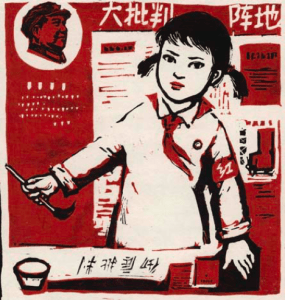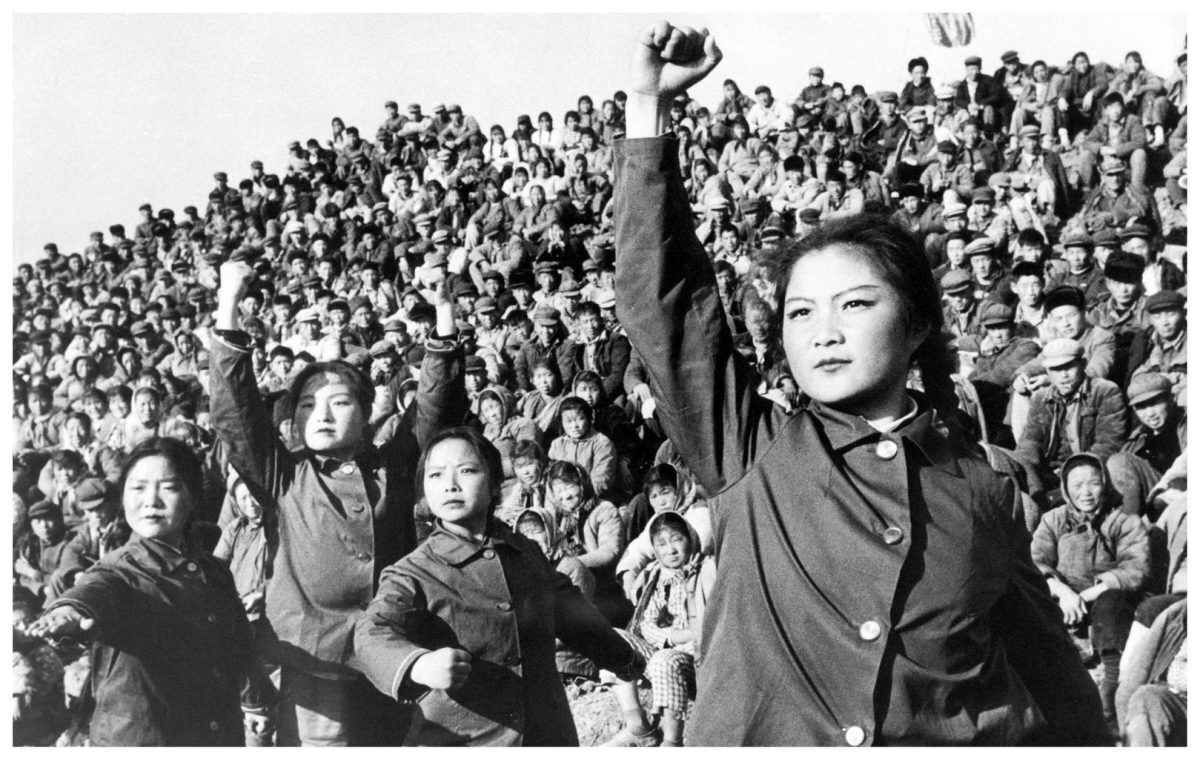Kulturrevolutionen begyndte i ånden, da Mao offentliggjorde et brev, der beskyldte et antal partiledere den 16. maj 1966. Men det var en tilsyneladende mindre begivenhed ni dage senere, der antændte den aktuelle revolution: en ung filosofiprofessor ved Peking Universitet ved navn Nie Yuanzi Placerede en 'plakat med store bogstaver' (et håndskrevet propagandaark med store kinesiske tegn) på en offentlig opslagstavle, der fordømmer universitetspræsidenten og andre i administrationen som borgerlige revisionister. Mao støttede øjeblikkeligt hendes protest, der udløste en kædereaktion af studenteroprør, der fejede gennem Kina.
Kommentar: Delvist oversat af Sott.net fra The youth of China were the enforcers of Mao's cultural revolution
That chain reaction was accelerated by "working groups" of ideologues sent to administer schools. Under their tenure, schools became centers of activism rather than learning. Students were encouraged to create big-character posters exposing their own teachers, officials, and even parents. The accused were humiliated in daily "struggle sessions" in which their students and colleagues interrogated them and demanded confessions. The viciousness of these sessions rapidly intensified. Students beat, spat upon, and tortured — in horrifically creative ways — their often elderly teachers and professors. In one case, students demanded their biology professor stare at the sun with wide open eyes. If he blinked or looked away, they beat him. Even middle and elementary school students participated in the struggle sessions, sometimes beating their teachers to death with sticks and belt buckles.

Mao's decision to use China's youth as his vanguard was, by fortune or foresight, instrumental to the revolution's initial success. The young may be pure in heart, but they are also high on emotion and short on life experience. Simply put, they are natural philistines. Still in their identity-forming years, China's young had few barriers to a complete identification with the Red Guards. Conformity and intolerance of dissent followed naturally. When students were not attending rallies and struggle sessions, they spent endless hours studying and discussing Mao's Little Red Book. As Lu Li'an, a former Red Guard, explained, "We were taught only about revolution so when we read the works of propaganda literature we really wanted to be at the head, at the vanguard of revolutionary history." With undeveloped mental immune systems, their soft skulls were fertile ground for Mao's secular Manichaeism. Manichaeism reduces society, with all the diversity and complexity of human experience, to a blunt dichotomy: light and darkness, good and evil, right and wrong, radical and reactionary. "There is no middle way!" became a popular slogan. Ideologies like these are intellectually and morally vapid, yet their simplicity and certainty are alluring, especially to the young. Thus, Mao's child revolutionaries could — with youthful exuberance and clarity of purpose — chain a teacher to a radiator and bludgeon him to death with an iron bar, or force a teacher to eat nails and feces, among other tortures.

Although educators and intellectuals were primary targets of the revolution, they bore some responsibility, by acts of commission or omission, for creating the conditions of its possibility. In the years prior to the Cultural Revolution, the Party had cultivated an environment of extreme political conformity. Political rallies and self-criticism sessions had become a regular feature of Maoist thought-reform campaigns.2 Ji Xianlin, a professor of languages at Peking, detailed how eagerly the teachers and intellectuals had supported these campaigns. In his memoir, The Cowshed, Memories of the Chinese Cultural Revolution, Ji writes with regret of his own "aptitude in crowd behavior." He had been a true believer in Maoism and willingly persecuted other intellectuals during the Socialist Education Movement in 1957. But his Party loyalty was no defense when the revolution eventually came for him. A year into the Cultural Revolution, he found himself denounced by friends, colleagues, and students. Already in his late fifties, he was imprisoned with other intellectuals in a cowshed with former students as his sadistic prison guards. He was forced to endure constant struggle sessions and beaten and tormented mercilessly by his colleagues and Red Guards.
Eventually, even Mao acknowledged that the situation was spiraling out of control. In 1967, the People's Liberation Army (PLA) was ordered to suppress the Red Guards, and they did so with great brutality. Many of the young radicals were killed in clashes with the PLA, while countless others perished in mass executions. But most were sent to labor camps in the countryside (including Nie Yuanzi, the young professor who had hung the first big-character poster at Peking University). After the Red Guards were contained, the intensity of the Cultural Revolution declined. It officially ended with Mao's death in 1976. All told, the death toll is estimated to have been between 400,000 and several million people. Tens of millions more were injured in acts of extreme cruelty and depravity.
The word "revolution" connotes turning, cycling, revolving. Cycles (and perhaps revolutions) are inescapable in nature, the laws of which command, with unbroken precedent, that the young will succeed the old. The Cultural Revolution, however, was deeply defective. Led by young idealists and animated by the forces of purity and paranoia, the revolution could yield only mayhem. No society, no person, no thing can satisfy the platonic ideal of purity. Hence, its pursuit ensured no end to struggle. More insidiously, the target of purification — the enemy, the disease, the rot — was internal. External threats are visible. They announce themselves by flag, appearance, ethos, and the like. The internal threat is hidden. The enemy is at once nowhere and everywhere. Thus, everyone was suspect: teachers, friends, and even family members. Hidden enemies must be exposed before they can be purified. Therefore, self-criticism, re-education, and public confession are peculiar but necessary practices in the inward war. Show trials, struggle sessions, and inquisitions satisfy the ideology's existential need for conflict by creating enemies out of comrades. In order to avoid persecution during the Cultural Revolution, many were quick to accuse others, thereby creating a feedback loop of ever intensifying ideological fanaticism and violence. Inevitably, the accusers became the accused, and the torturers became the tortured.
As each confession validated the Red Guards' paranoia, the revolution mutated into something like an autoimmune disorder that attacks what it is meant to protect. This was, in fact, what the CCP's Central Committee concluded about the Cultural Revolution in 1981. In a remarkably candid retrospective, the Central Committee acknowledged that "it was we and not the enemy at all who were thrown into disorder by the 'Cultural Revolution'" which they judged responsible for "the most severe setback and the heaviest losses suffered by the Party, the state, and the people since the founding of the People's Republic."
The revolution's descent into anarchy and violence calls to mind the first stanza of W.B. Yeats' famous poem "The Second Coming," which begins with the "Turning and turning in the widening gyre." For the Cultural Revolution it reads like prophecy, a forewarning of what transpires when a people, united around a single unassailable vision, finds its enemies by turning inwards. With no competing visions or ability to self-correct, the turning continues, the gyre widens, and soon:
Things fall apart; the centre cannot hold;Much has been written recently about the excesses of political polarization and the prevalence of an "us versus them" mentality in politics. The Cultural Revolution, however, offers a chilling example of the dangers of an excess of political homogeneity. To be sure, Maoism preached the Manichean gospel of good versus evil. But all were agreed that Maoism was correct, even (sometimes especially) those who were purged. Conflicts were only over who practiced the purest version of the ideology, not over competing doctrines — because there were none. It was this lack of a distinguishable "us" and "them," that drove the revolution to turn inward in search of enemies and impurities.
Mere anarchy is loosed upon the world,
The blood-dimmed tide is loosed, and everywhere
The ceremony of innocence is drowned;
The best lack all conviction, while the worst
Are full of passionate intensity.
In liberal democracies, by contrast, purity politics may occur within factions and parties. But the real competition is between conflicting political values and ideologies, all of which provide the productive tension that drives social progress. Of course, liberal democracy is itself a political ideology, but it is uniquely structured around a conception of pluralism that can accommodate disparate visions of what constitutes the good life. Elections, among other things, act as self-correcting mechanisms: a party that purges its impure elements inevitably strengthens its competition. This limits the potential depravity and destructiveness of purity politics, which was not the case in China.
Nevertheless, the instinct to conform and to be accepted by our peers is strong within us all — especially the young. When the undercurrents of popular culture pull us towards conformity, democracy alone is no cure. Nor is it enough to preach tolerance: there must also exist a multiplicity of views to tolerate. When we tell ourselves and teach our children that "diversity is our strength," it can sound a lot like dogma. Even so, it is a dogma worth supporting if it is intended to extoll diversity of thought and opinion; a diversity that rewards contrarians who reject the safety of the herd, and those who embody the spirit of dissent, nonconformity, and individualism. Nietzsche once warned that "the surest way to corrupt a youth is to instruct him to hold in higher esteem those who think alike than those who think differently." It is a warning we should heed.
James David Banker is an attorney and writer. He studied linguistics at Cambridge, law at Stanford, and philosophy in the Special Forces. You can follow him on Twitter @jdbanker1References:
1 John Bowman. (2005) Columbia Chronologies of Asian History and Culture. p73.
2 Ji Xianlin, and Chenxin Jiang. (2016) The Cowshed: Memories of the Chinese Cultural Revolution. p18.




Læserkommentarer
dig vores Nyhedsbrev